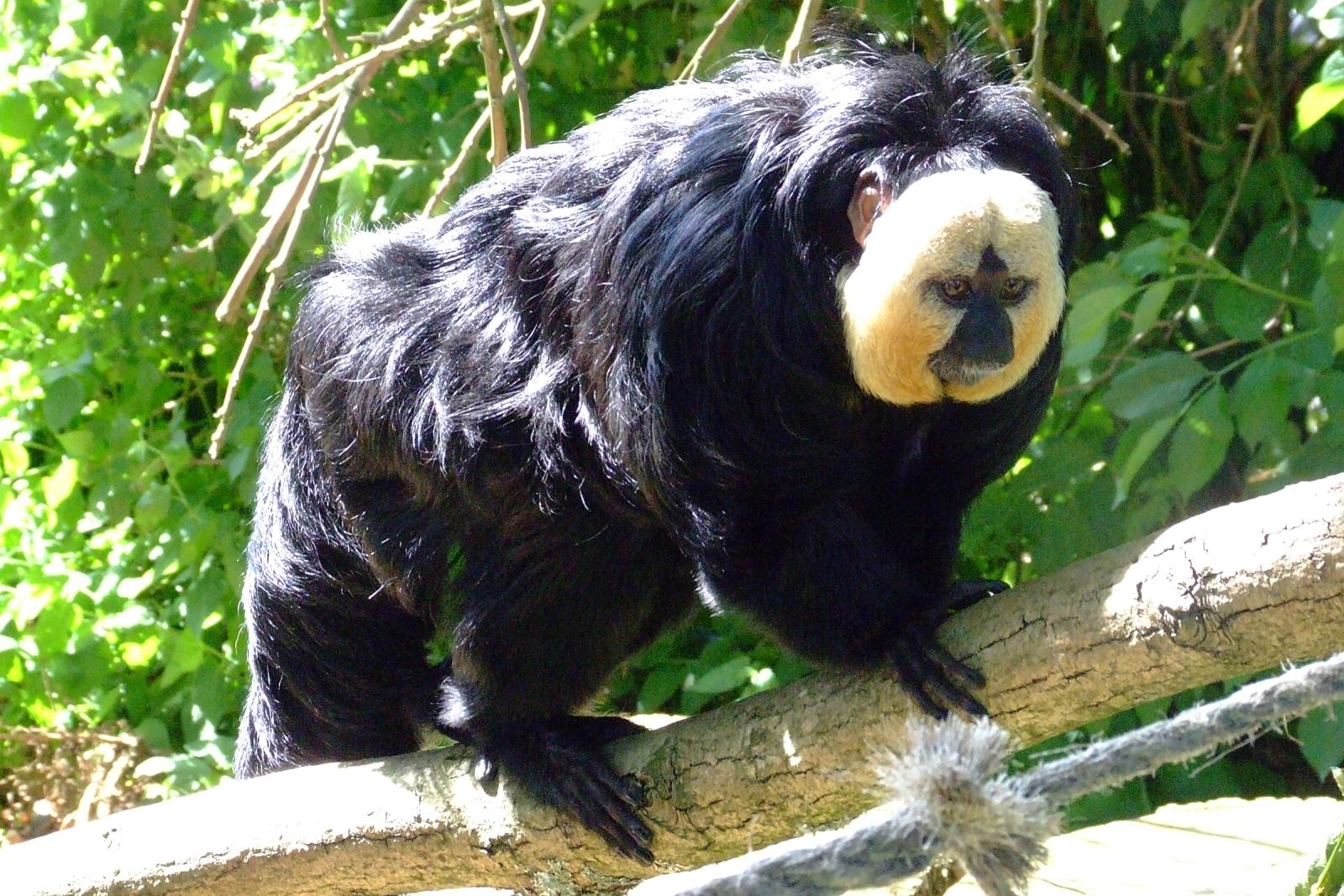
Golden-faced saki, orWhite-faced saki (Pithecia pithecia)
Phylum —chordata
Class — mammalia
Order — primates
Family — pitheciidae
Genus –pithecia
Appearance
White-faced sakis exhibit sexual dimorphism, with larger males, and sexual dichromatism. Males have a black coat with white fur that surrounds their face. Female sakis have a shorter, brownish grey coat with two vertical lines from their eyes to their nose. Females may also have orange brown colored fur that emerges around the chest area and continues down to their abdomen. At birth males and adult females are very similar in appearance. A gradual color change over 3.5 to 4 years occurs, in which male sakis become all black with bright white faces. Sakis have long bushy tails, which are used for balance while jumping from tree to tree. The tails are not used for grasping objects or branches. Average adult mass is 1.8 kg; however, a slight sexual dimorphism separates males (2.38 kg) from females (1.76 kg).
Habitat
The natural range of this species includes parts of Brazil, some remote areas of the neighboring Venezuela as well as the major parts of French Guiana, Guyana and Suriname. Within this territory, White-faced sakis are distributed throughout upland and lowland rainforests, occurring along the Cuyuni river basin, between the Caroni and the Orinoco Rivers.
Behavior
White-faced sakis gather into very small units of only 2 - 4 individuals. Group members take daily trips of 1 - 2 kilometers. They are most active in the early morning and early afternoon. As much as 9 hours of their active time are spent travelling. Mutual grooming is very important activity for these primates, performed by males and females and particularly, between mothers and infants. Experienced individuals teach young ones skills of infant care. Populations in captivity exhibit communal care with all members of the group helping rear offspring of each other. When moving, they use all of their four limbs. These monkeys actively use vocalizations in the daily life. The most common calls are chirps and high-pitched whistles. Meanwhile, loud calls act as territorial display. When facing a threat, these animals give out growling noises, puff themselves up to look bigger than they are as well as shake branches of trees at full strength.
Diet
The White-faced sakis are herbivores (folivores, frugivores and granivores), but generally their diet consists of as much as 90% fruits. They are also known to feed upon seeds, leaves, flowers and occasional insects.
Reproduction
Captive individuals of this species (such as those in zoos) generally exhibit monogamous mating system with very rare exceptions. Meanwhile, those in the wild tend to be either polygynous (where a single male mates with numerous females) or polyandrous (where a single female mates with numerous males), especially groups of more than 2 - 3 individuals. The reproductive system is also determined by the proportions of males and females in a given group.
Reproduction occurs during the spring months. A single infant is born after 146 - 170 days of gestation. The baby grows up very quickly. Older siblings of the last 1 - 2 years usually contribute to rearing the newborn monkey. It's independent at 6 months old, although remains with its natal group before leaving at 1 year old. White-faced sakis are able to produce offspring of their own at 4 years old.
White-faced sakis typically live around 14 years in their natural habitat and have been recorded to live up to 36 years in captivity.
In captivity
Keeping sakis has certain difficulties due to the lack of resistance to stress. Sakiscan panic quickly. For example, even if you move the cage with the monkey, it will be shocked. Usually they are kept in cages. Try to put ropes, tree branches, shelves, etc. in the cage. It is preferable to plant fast-growing trees and shrubs (such as poplar, willow, acacia, sea buckthorn) in aviaries for them.
In captivity, they eat fruits, vegetables, bread, porridge or soaked (sprouted) grain – rice, peas, wheat, barley, boiled fish (or seafood) and meat, corn on the cob.
 Russian
Russian
 English
English























